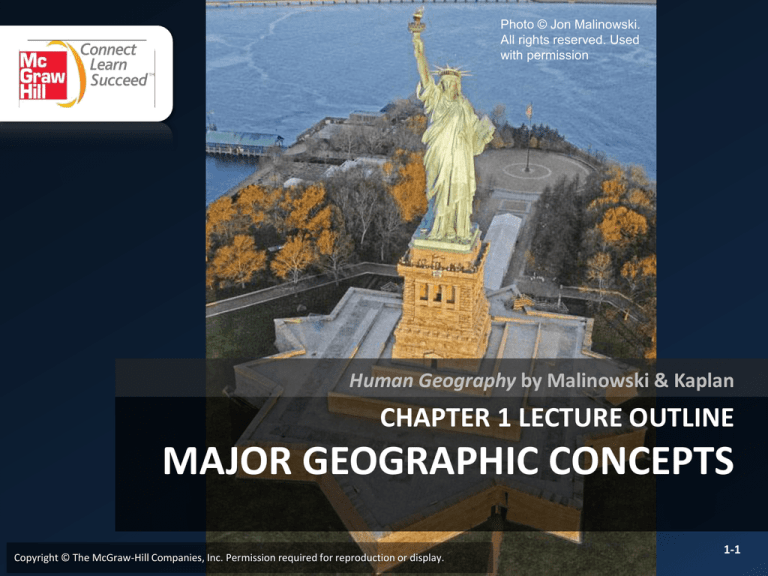
Photo © Jon Malinowski.
All rights reserved. Used
with permission
Human Geography by Malinowski & Kaplan
CHAPTER 1 LECTURE OUTLINE
MAJOR GEOGRAPHIC CONCEPTS
Copyright © The McGraw-Hill Companies, Inc. Permission required for reproduction or display.
1-1
Chapter 1 Modules
•
•
•
•
•
•
•
•
1A Pattern and Process
1B Absolute and Relative Location
1C Place and Space
1D Place Attributes and Significance
1E Mapping Spatial Distributions
1F Spatial Interactions and Distance
1G Regions
1H Idea of Landscape
Copyright © The McGraw-Hill Companies, Inc. Permission required for reproduction or display.
1-2
1A: Pattern & Process
• Pattern
– a spatial arrangement of a phenomenon
• Process
– the action that brings about a particular pattern
– in human geography, processes tend to be
probabilistic
– may be multivariate and multiscalar
Copyright © The McGraw-Hill Companies, Inc. Permission required for reproduction or display.
1-3
1B: Absolute & Relative Location
• Absolute Location
– where something
exists on a reference
system
• Relative Location
Insert Figure 1B.1
– Location compared
to other places or in
context
– Site vs. Situation
Copyright © The McGraw-Hill Companies, Inc. Permission required for reproduction or display.
1-4
Figures 1B.2 & 1B.3
Copyright © The McGraw-Hill Companies, Inc. Permission required for reproduction or display.
1-5
1C: Place & Space
• Place
– Can refer to a series of
concrete attributes or can
imply diverse meanings
attached to a location
• Space
– A two-dimensional area
that contains a number of
places and boundaries that
may or may not be clearly
defined.
Copyright © The McGraw-Hill Companies, Inc. Permission required for reproduction or display.
1-6
Figure 1D.1
Copyright © The McGraw-Hill Companies, Inc. Permission required for reproduction or display.
1-7
1E: Mapping Spatial Distributions
• Thematic Maps
– show the distribution, flow, or connection of one or
more characteristics
• Point Pattern Map
– each incident is displayed as a point
• can show whether a distribution is dispersed or
clustered
• Choropleth Maps
– show the quantity or type of phenomena by area
Copyright © The McGraw-Hill Companies, Inc. Permission required for reproduction or display.
1-8
Figure 1E.2
Copyright © The McGraw-Hill Companies, Inc. Permission required for reproduction or display.
1-9
1F: Spatial Interactions & Distance
• Spatial Interaction
– the movement and interconnections between places.
• Influenced by accessibility
• Distance
– Absolute / Euclidean distance
• Travel distance
– Travel time
– Cognitive distance
Copyright © The McGraw-Hill Companies, Inc. Permission required for reproduction or display.
1-10
Travel Time
Copyright © The McGraw-Hill Companies, Inc. Permission required for reproduction or display.
Figure 1F.4
1-11
Distance Decay
Copyright © The McGraw-Hill Companies, Inc. Permission required for reproduction or display.
Figure 1F.5
1-12
1G: Regions
• A way of
subdividing space
into categorizable
geographic units.
• Types:
– Formal
– Functional
– Vernacular
Copyright © The McGraw-Hill Companies, Inc. Permission required for reproduction or display.
1-13
Formal Regions
Figure 1G.4
Composed of places that have one or
more characteristics in common.
Copyright © The McGraw-Hill Companies, Inc. Permission required for reproduction or display.
1-14
Functional Regions
Figure 1G.6
Activity space
Regions constructed out of places that
interact.
Copyright © The McGraw-Hill Companies, Inc. Permission required for reproduction or display.
1-15
Vernacular Regions
Figure 1G.8
Regions that people construct in their mind.
Copyright © The McGraw-Hill Companies, Inc. Permission required for reproduction or display.
1-16
1H: Idea of Landscape
• An area that is less
defined than a region
and is described in an
abstract manner.
• Types:
– Ordinary
– Iconic
– Interior
Copyright © The McGraw-Hill Companies, Inc. Permission required for reproduction or display.
1-17







